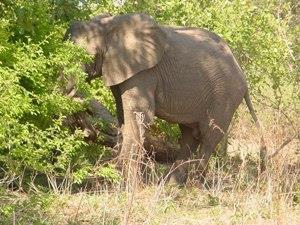Malvern Karidozo
This project seeks to characterize, map, prioritize and secure viable elephant movement corridors in Livingstone, Zambia in a bid to reduce human wildlife conflicts using a landscape approach.
An enumerator ground tracking collared elephants.
The general objectives of the project are to determine the wildlife movement patterns and corridors as well as the nature and patterns of conflict in relation to habitat use, to identify, characterize and map human wildlife conflict hotspots and develop a GIS database on human-wildlife conflicts with much focus on elephants. The project also aims at proposing landscape structures relevant to the findings of this study.

Human-wildlife conflict is a critical problem for wildlife conservation in Africa. Conflict between rural farmers and wildlife occurs where agriculture expands and wildlife range is compressed, leading to direct competition for land and natural resources. In the Zambezi Valley of Zambia in Livingstone, human and wildlife populations coexist in a landscape mosaic. As the major contributor to community-based conservation, wildlife, particularly elephants are viewed as a key resource. Conflict is widespread and occasionally severe. Agricultural expansion and of late tourism threatens wildlife habitat, through rapid and unplanned conversion of forest to farmland or lodgings. The elephant population within the study area is currently contiguous, and radio tracking of elephants in this area over two years has disclosed core refuge areas linked by widespread seasonal movements. Elephants are ranked among the major contributors to community-based conservation and tourism operations, but if they are to be effectively conserved, their requirements for habitat and their impacts upon the human farming and tourism population must be fully investigated and addressed.
The project seeks to influence and advocate for developments that keep settlements out of wildlife movement corridors, feeding and shelter areas to reduce the said conflicts. It also seeks to make an impact where growth and development takes place on the landscape to advise land use planning.
The project appreciates that the prognosis for conservation of wildlife, their movement corridors and habitats seems exceedingly grim if land-use changes remain unchecked and not investigated thus calls for a participatory and integrated landscape level approach to solving the issues of human wildlife conflict thereby fostering wildlife conservation and community livelihoods.